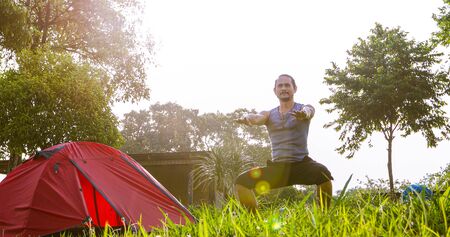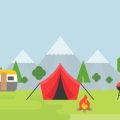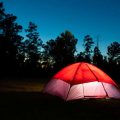Embracing the Autumn Outdoors
There’s something truly special about heading out for a solo camping trip in the fall. As summer fades and crisp air settles in, the world outside transforms into a vibrant canvas of red, orange, and gold. For many campers in America, this season is more than just a change in weather—it’s an invitation to slow down and soak up the quiet beauty that only autumn can bring.
The Magic of Fall Scenery
Solo fall camping lets you experience nature at its most peaceful. The forests are less crowded, wildlife is active as animals prepare for winter, and every step on the trail crunches with freshly fallen leaves. The cool air feels refreshing, and the shorter days make campfires even cozier. It’s the perfect time to enjoy nature’s show without distractions.
Why Camp Alone in Fall?
| Reason | Description |
|---|---|
| Fewer Crowds | Parks and campsites are quieter, letting you enjoy solitude. |
| Spectacular Views | Changing leaves and clear skies create picture-perfect scenery. |
| Mild Weather | Cool temperatures make hiking and sleeping more comfortable. |
| Personal Reflection | The peaceful setting encourages mindfulness and relaxation. |
Seasonal Changes to Appreciate
Fall isn’t just about pretty leaves. It brings unique sounds, like geese flying south or acorns dropping from trees. The scent of earth and woodsmoke fills the air. Sunrise comes later, giving you a chance to watch morning mist roll across lakes or meadows. Every moment outdoors offers a fresh perspective—and plenty of opportunities to unwind and reconnect with yourself in nature’s embrace.
2. Gearing Up for a Safe Solo Adventure
Essential Gear for Fall Camping
Packing the right gear is crucial when heading out for a solo fall camping trip. Autumn brings cooler temperatures and unpredictable weather, so it’s important to be prepared for anything. Here’s a quick guide to must-have items:
| Gear | Why You Need It |
|---|---|
| Four-season tent | Offers extra protection from wind and chilly nights |
| Sleeping bag (rated for cold weather) | Keeps you warm when temperatures drop overnight |
| Sleeping pad or insulated mat | Provides insulation from the cold ground |
| Headlamp with extra batteries | Shorter daylight hours mean you’ll need reliable light sources |
| Portable camp stove and fuel | Hot meals make a big difference in cold weather |
| Water filter or purification tablets | Ensures safe drinking water wherever you set up camp |
| First-aid kit (with personal meds) | Covers minor injuries and emergencies when help is far away |
| Map, compass, or GPS device | Keeps you on track even if cell service drops out |
| Trekking poles | Add stability on slippery or uneven trails covered in leaves |
| Bear spray (in bear country) | A precaution that’s standard in many U.S. wilderness areas |
| Whistle and emergency blanket | Useful for signaling and warmth in unexpected situations |
Dressing Right: Layering for Fall Weather
The key to staying comfortable during fall camping is layering. Weather can shift quickly, so dress in layers that you can easily add or remove. Here’s a simple breakdown:
| Layer Type | Examples/Materials |
|---|---|
| Base Layer (moisture-wicking) | Synthetic or merino wool long underwear tops & bottoms |
| Mid Layer (insulating) | Fleece jacket, down vest, or synthetic insulated hoodie |
| Outer Layer (weatherproof) | Waterproof shell jacket & pants, windbreaker |
Don’t forget a warm beanie, gloves, and thick socks—these small items make a huge difference as temperatures dip.
Packing Smart: Safety Precautions for Solo Campers
Create a Trip Plan and Share It
Before you hit the trail, let someone trustworthy know your itinerary—including your planned route, campsite location, and when you expect to return. This is a common safety step among American solo campers.
Check the Weather Forecast
Autumn storms can roll in fast. Always check the latest forecast before leaving and prepare for sudden changes—bring rain gear even if skies look clear.
Campsite Selection Matters
Pick higher ground away from rivers or low spots where cold air settles at night. Avoid pitching your tent under dead branches (“widowmakers”). Choose visible locations if you’re near hiking trails but also seek some privacy from main paths.
Stay Bear Aware
If you’re camping in areas with bears (like the Rockies, Appalachians, or Pacific Northwest), store food in bear-proof containers and cook at least 100 feet from your sleeping area. Never keep food inside your tent.
Navigating Alone? Know Your Limits!
If you’re new to solo camping, stick to established trails and campsites. Trust your gut—if something feels off, don’t hesitate to turn back or change plans. Always carry a whistle for signaling if you get lost.
Your Fall Adventure Starts with Preparation
Packing smartly and following basic safety steps will help ensure your solo fall camping trip is safe, comfortable, and truly peaceful. Take time to enjoy the crisp air, golden leaves, and quiet moments all around you as you find tranquility in nature.

3. Choosing the Perfect Campsite
Finding Solitude and Scenic Beauty
When it comes to solo fall camping, your campsite choice can make or break the experience. You’ll want a spot that feels peaceful and remote, but also offers stunning views of fall foliage. Start by researching state parks, national forests, and lesser-known campgrounds that are less crowded in autumn. Look for campsites that are set back from main trails or away from busy areas so you can truly soak in the tranquility.
Key Features to Consider
| Feature | Why It Matters | Tips |
|---|---|---|
| Scenic Views | Enhances your experience with beautiful fall colors | Look for spots near lakes, rivers, or ridgelines with open vistas |
| Privacy | Allows you to unwind without distractions | Choose walk-in or hike-in sites for more seclusion |
| Shelter from Wind | Keeps you comfortable as weather changes | Select sites protected by trees or natural land features |
| Sun Exposure | Keeps you warm during chilly mornings and evenings | A south-facing site gets more sunlight in fall |
Wildlife Awareness
The fall season is an active time for wildlife getting ready for winter. While spotting deer or hearing owls can be magical, keep in mind safety and food storage. Avoid setting up near dense berry bushes or animal trails, and always use bear-proof containers where required.
Wildlife Safety Tips
- Store food and scented items away from your tent—use a bear box or hang your food if necessary.
- Keep a safe distance from animals; do not try to feed or approach them.
- Familiarize yourself with local wildlife habits before heading out.
Be Prepared for Changing Weather
Fall weather can shift quickly—warm afternoons might turn into frosty nights. Choose a campsite with natural drainage to avoid puddles if it rains. Check the forecast before heading out, and pack accordingly: think extra layers, a reliable rainfly, and cold-weather sleeping gear.
Packing Essentials for Fall Camping:
- Insulated sleeping pad and sleeping bag rated for low temperatures
- Waterproof tent with a secure rainfly
- Layered clothing (base layer, fleece, waterproof shell)
- Headlamp or lantern (days get shorter in fall!)
- Backup fire-starting supplies (matches, lighter, fire starter)
By keeping these factors in mind when choosing your campsite, you’ll set yourself up for a safe, serene solo camping adventure surrounded by the best of autumn’s beauty.
4. Campfire Comfort: Cooking and Staying Warm
Easy & Satisfying Campfire Meals
When you’re out solo camping in the fall, there’s nothing like a warm meal by the fire. Fall nights can get chilly fast, so it’s smart to keep your campfire menu simple and hearty. Here are some classic American favorites that are easy to make over an open flame:
| Meal Idea | Ingredients | How-To |
|---|---|---|
| Chili in a Can | Canned chili, shredded cheese, crackers | Heat chili in a pot over the fire, top with cheese, serve with crackers. |
| Campfire Quesadillas | Tortillas, shredded cheese, cooked chicken or beans, salsa | Fill tortillas, fold, wrap in foil, and heat on coals for 5-10 minutes. |
| S’mores Breakfast Sandwich | Bread, peanut butter, banana slices, chocolate chips | Spread peanut butter on bread, add bananas and chocolate chips, grill in foil until melty. |
| Foil Packet Veggies & Sausage | Sliced sausage, potatoes, carrots, onions, olive oil, seasoning | Toss everything in foil with oil and seasonings; cook on coals for 20-25 minutes. |
Staying Cozy All Night Long
The crisp autumn air is refreshing during the day but can turn downright cold at night. Staying warm is all about smart layering and keeping your campsite snug. Here are some practical tips for staying comfortable while you soak up the peace of nature:
Layer Up Wisely
- Base Layer: Moisture-wicking long underwear (avoid cotton).
- Middle Layer: Insulating fleece or down jacket.
- Outer Layer: Windproof and waterproof shell.
- Socks & Hat: Wool socks and a beanie help retain body heat.
Campsite Warmth Hacks
- Pile on Blankets: Extra blankets or a sleeping bag liner add warmth without much weight.
- Hot Water Bottle Trick: Fill a metal water bottle with hot (not boiling) water and tuck it into your sleeping bag before bed.
- Sit Close to the Fire: Pull up your camp chair right by the flames—but remember fire safety!
- Insulate from the Ground: Use a foam pad under your sleeping bag to block ground chill.
- Keep Your Tent Ventilated: Crack your tent window just enough to reduce condensation without letting in too much cold air.
A Little Comfort Goes a Long Way
No matter how cool it gets outside, these simple meals and cozy tricks will help you enjoy every peaceful moment of your solo fall camping adventure. Embrace the quiet—there’s no better way to recharge than by warming up next to a crackling fire with a tasty bite in hand!
5. Finding Mindfulness in Nature
Solo fall camping is more than just an adventure—its a chance to slow down and truly connect with the natural world around you. Practicing mindfulness can make your solo camping trip even more rewarding, helping you find tranquility and a deeper sense of peace. Here are some simple ways to explore mindfulness while enjoying your autumn escape:
Journaling in the Wild
Bringing a small notebook on your solo camping trip is a great way to capture your thoughts and experiences. Try setting aside a few minutes each morning or evening to jot down what you see, hear, smell, or feel. Whether it’s the crunch of fallen leaves underfoot or the crisp scent of pine, writing these moments helps you stay present and appreciate the beauty around you.
Simple Journaling Prompts
| Prompt | How It Helps |
|---|---|
| What sounds do I notice right now? | Encourages active listening and awareness of your environment. |
| How does the air feel against my skin? | Brings attention to physical sensations and grounds you in the moment. |
| What colors do I see around me? | Increases appreciation for nature’s details and vibrant fall scenery. |
Mindful Hiking Practices
Walking mindfully through the woods or along a lake allows you to tune into every step and breath. Try slowing your pace, focusing on each footfall, and taking deep breaths as you go. Notice how your body feels, how your surroundings change, and how the autumn light shifts through the trees. This mindful approach turns an ordinary hike into a calming meditation.
Easy Mindful Activities for Solo Campers
| Activity | Description |
|---|---|
| Silent Sunrise Watch | Sit quietly at dawn, simply observing the changing sky and sounds of waking wildlife. |
| Leaf Collecting Walk | Gather colorful leaves while focusing on their texture and patterns—no distractions, just nature. |
| Sensory Breaks | Pause during hikes to consciously engage all five senses—what can you hear, see, smell, touch, or even taste? |
Tuning Out Distractions
Avoid reaching for your phone unless necessary. Unplugging gives you space to unwind and notice things you might otherwise miss—the way light dances across a river, or how wind rustles through golden leaves. Let yourself fully experience each moment without digital interruptions.
By adding mindful practices like journaling or slow hiking into your solo fall camping adventure, youll find it easier to relax, recharge, and discover new levels of tranquility in natures embrace.


